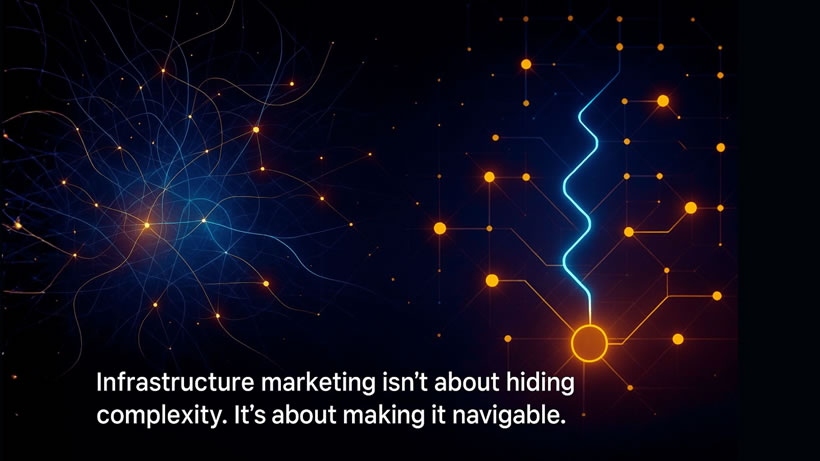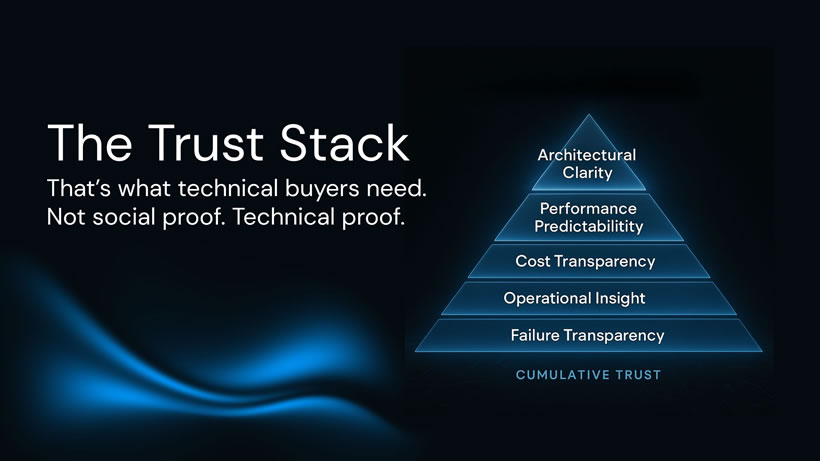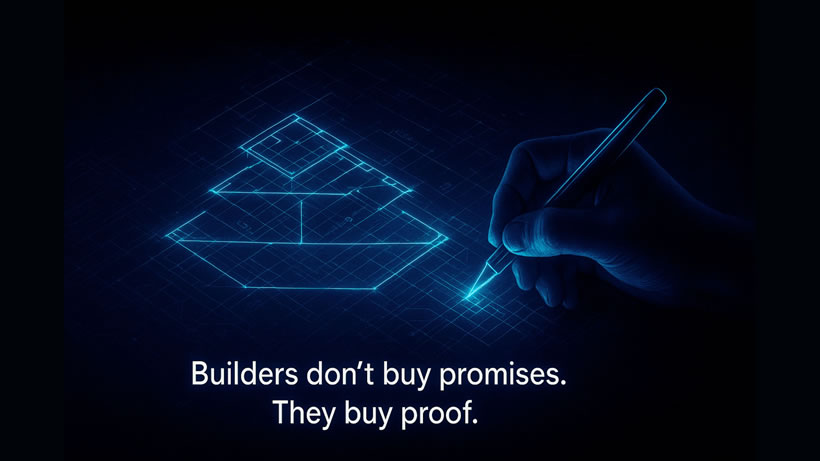Summary
You can’t market AI like it’s magic. I know that’s counterintuitive. The entire consumer AI narrative is built on magic, frictionless interfaces, invisible complexity, results that feel like sorcery.
ChatGPT doesn’t explain how attention mechanisms work. Midjourney doesn’t describe diffusion models. Nobody markets transformers. They market miracles. And for consumer products, that works. Maybe it even has to work.
But for the infrastructure layer, for the platforms that developers build on, the compute that powers models, the tools that operationalize AI at scale, magic is the wrong story. Builders don’t buy magic, they buy power, control, reliability, understanding, and infrastructure they can trust. And trust doesn’t come from promises about what AI will do. It comes from transparency about how it works, what it costs, where it breaks, and what you can actually build with it.
The real story is what’s under the hood, not isn’t the outputs.
That’s where adoption starts. That’s where category leadership is built. And most AI infrastructure companies are getting it wrong.

Why The Magic Narrative Fails for Infrastructure
I’ve spent the last three years watching AI infrastructure companies try to market themselves. Most start by copying the consumer playbook: demo the magic, hide the complexity, make it look effortless. They lead with the outcome: “10x faster inference.” “Deploy models in minutes.” “AI that just works.” Then they wonder why developers don’t convert. Why technical evaluators ask questions the marketing team can’t answer. Why deals stall in technical validation.
The problem isn’t the product. It’s the mismatch between what builders need to believe and what marketing is trying to prove.
Builders are professional skeptics.
They’ve been burned by abstraction layers that leak. By “simple” platforms that can’t handle their edge cases. By promises of performance that evaporate under real-world load. They don’t want to be sold to. They want to understand.
“Magic” is the opposite of understanding. When you market AI infrastructure as magic, you’re asking builders to trust a black box; to believe in capabilities they can’t verify. To bet their architecture on claims they can’t test. That’s not how technical adoption works.
Technical buyers adopt infrastructure when they can:
- Understand the architecture well enough to trust it
- Predict performance characteristics before they commit
- See evidence that it works for use cases like theirs
- Know what happens when things go wrong
- Assess whether you understand the problem as deeply as they do
None of that comes from magic. All of it comes from transparency.

What Infrastructure Marketing Actually Is
Here’s what most AI companies miss: infrastructure marketing isn’t about hiding complexity and simplifying the message. It’s about making complexity navigable and respecting the intelligence of your audience.
The best infrastructure marketing I’ve seen in the last 25 years, across databases, cloud platforms, developer tools, and now AI, always has the same characteristics:
- Architecture transparency
Show the system design. Explain the trade-offs. Be explicit about what you optimized for and what you sacrificed to get there. Developers know there’s no such thing as a free lunch in distributed systems. If you’re claiming speed and reliability and low cost, they’re trying to figure out where the compromise is. If you hide it, they’ll assume the worst. If you explain it, they’ll respect the honesty.
This doesn’t mean dumping technical docs into your homepage. It means your narrative acknowledges reality: “We optimized for X, which means Y performs differently than Z, and here’s why that trade-off makes sense for these use cases.”
That’s not a weakness. That’s credibility.
- Performance specificity
Generic claims die in technical evaluation. “Fast inference” means nothing. Fast compared to what? Under what conditions? With what model sizes? At what scale?
Infrastructure buyers live in specifics. They need numbers. They need benchmarks. They need to know whether your “fast” matches their definition of fast for their workload.
The companies that win give them the data: “Llama 2 70B at 47 tokens/second on H100s with batch size 8 and sequence length 2048.” That’s not marketing copy. That’s technical truth. And technical truth is what builds trust.
- Honest limitation disclosure
Every platform has constraints. Edges where performance degrades. Use cases it’s not built for. Known issues in the backlog. Weak companies hide these until the trial phase or technical diligence.
Strong companies surface them early: “This works incredibly well for X and Y. If you’re doing Z, here’s what you’ll hit, and here’s how we recommend working around it.”
That feels like risk. It’s actually the opposite because developers will find your limitations anyway. The question is whether they discover them during evaluation, when they can make an informed choice, or after they’ve committed, when it feels like betrayal.
Disclosure builds trust. Concealment destroys it.
- Evidence from the trenches
Case studies in infrastructure marketing aren’t about customer logos. They’re about proof that the system works under real conditions.
Not: “Company X uses our platform.”
But: “Company X migrated 47 models from AWS to our platform, reduced latency by 34%, cut costs by 52%, and here’s exactly what their architecture looks like, what problems they hit, and how they solved them.”
That’s what technical buyers need. Not social proof. Technical proof. They want to see someone who had their problem, tried your solution, and made it work. With enough detail that they can assess whether their situation maps to it. The more specific you are, the more credible you become.

The Trust Stack for AI Infrastructure
When I’m evaluating AI infrastructure marketing, I look for what I call the trust stack—five layers that need to work together:
Layer 1: Architectural clarity
Can I understand how this works? Not every implementation detail, but enough to mentally model the system?
Do I know what happens when I send a request? Where the compute happens? How data moves? What gets cached? Where latency comes from?
If the architecture is a black box, trust doesn’t form. Because I can’t predict behavior. And if I can’t predict behavior, I can’t build on it.
Layer 2: Performance predictability
Can I forecast how this will perform for my use case before I try it?
Do you give me enough information about performance characteristics—throughput, latency, concurrency limits, scaling behavior—that I can estimate whether this fits my requirements?
Or do I have to sign up, integrate, test, and hope?
The more you tell me upfront, the less risk I perceive.
Layer 3: Cost transparency
Can I calculate what this will actually cost me at scale?
AI infrastructure pricing is notoriously complex: per token, per second, per GPU hour, per request, tiered by model size, with commitment discounts and overage charges.
If I can’t model my costs with reasonable accuracy before I commit, I’m not committing. Because surprise bills kill adoption faster than technical limitations.
Layer 4: Operational insight
Can I see what’s happening inside the system when I’m using it?
Do I get observability into request latency, queue depth, error rates, resource utilization?
Can I debug when something’s slow? Can I optimize my usage? Can I understand where my costs are coming from?
Or is it a black box where I submit requests and hope they work?
Infrastructure buyers are operators. They need visibility.
Layer 5: Failure transparency
What happens when things break? Because things always break.
Do you have status pages? Incident reports? Postmortems that actually explain what went wrong and what you’re doing about it?
Do you communicate proactively when there are issues, or do I have to discover them myself?
How you handle failure tells me whether I can trust you in production. Because production is where failure happens.

Why Technical Founders Get This—And Why Marketing Teams Often Don’t
I’ve worked in marketing with technology and developers a long time. Almost always, there’s a split between how the two look at things:
Technical founders intuitively understand that builders need depth, not polish. They want to publish benchmarks, share architectural diagrams, write technical deep-dives. The marketing team pushes back: “That’s too technical. We need to simplify. We need a narrative that anyone can understand.” And there’s truth in both perspectives.
But here’s what I’ve learned: in infrastructure, technical depth is the narrative. Your audience isn’t “anyone.” It’s builders who are evaluating whether to bet their stack on you. They need signal, not simple. They need enough information to make an informed decision. They need to believe you understand the problem at their level. When you dumb it down, you’re not making it more accessible. You’re signaling that you don’t understand who you’re talking to.
The tech-based companies I’ve worked with, the ones that actually win developer mindshare, do something that feels counterintuitive: they let their founders and technical leaders be the voice of the brand. Not in a “tech bro on Twitter” way. But in a “here’s an in-depth technical post about how we solved this gnarly distributed systems problem” way. They publish architecture diagrams. They share performance benchmarks, warts and all. They write about the trade-offs they made and why. They show their work. And developers love it. Because it’s honest. It’s substantive. It treats them like the experts they are.
That builds trust faster than any amount of polished marketing copy.

The Documentation as Marketing Thesis
Here’s a controversial take: for infrastructure companies, documentation is marketing. Most companies treat docs as an afterthought. Something you build after the product is done. A cost center, not a growth driver. But in infrastructure, docs are often the first substantial interaction a developer has with your product. They’re not just reference material. They’re the experience of understanding what you built.
If your docs are sparse, unclear, or out of date, developers assume your product is the same.
If your docs are comprehensive, accurate, and well-structured, they assume your product is too.
I’ve watched developers choose between two equivalent platforms based entirely on documentation quality. Not because they needed the docs to use the product. Because the docs signaled competence, attention to detail, and respect for their time. The companies that get this treat documentation with the same rigor they treat product development:
- Architecture guides that explain system design and trade-offs
- Tutorials that don’t just show how to do something, but explain why it works that way
- Performance guides that help you optimize for your use case
- Migration guides that acknowledge the complexity of switching
- API references that are actually complete and accurate
- Example code that goes beyond “hello world” into real-world patterns
That’s not documentation. That’s product marketing that scales. That’s trust building that happens automatically, every time someone explores what you built.

The Metrics That Matter in Infrastructure Marketing
Most B2B marketing metrics are useless for infrastructure. MQLs mean nothing when your buyers are doing deep technical evaluation before they ever talk to sales. Conversion rates are misleading when the real question is: are the right people adopting for the right use cases?
Pipeline is vanity when deals take six months of technical validation before they close. The metrics that actually matter in infrastructure marketing are:
- Technical engagement depth: How many developers are reading your technical content? How deep are they going? Are they just skimming marketing pages or diving into architecture docs?
- Question quality: What are people asking in your community, support channels, or sales conversations? Sophisticated questions from people evaluating real use cases? Or basic questions from people who don’t understand what you built?
- Time to value—in evaluation: How long does it take someone to go from “I’m curious” to “I understand whether this solves my problem”? Can they self-qualify in hours, or does it take weeks of back-and-forth?
- Integration depth: Are people trying you for toy projects, or integrating into production systems? Are they building on top of you, or just kicking the tires?
- Builder quality: Are the people adopting you the kinds of technical leaders who influence architecture decisions in their organizations? The ones who write blog posts, speak at conferences, and set technical direction?
These are harder to measure than MQLs. But they’re what actually predicts whether you’re building sustainable adoption or just generating trial noise.

How AI Infrastructure Marketing Is Evolving
I’m watching the AI infrastructure market mature in real-time. And the companies that are pulling ahead are the ones that stopped trying to out-magic each other and started competing on substance.
- They’re publishing detailed benchmarks, not just their own, but reproducible ones that others can validate.
- They’re sharing architectural deep-dives that explain how they achieved their performance characteristics.
- They’re building communities where builders share what they’re building, what’s working, what’s not.
- They’re treating their technical users as partners in developing the platform, not just consumers of it.
- They’re being honest about trade-offs, limitations, and where the product is still evolving.
And it’s working. Because in a market flooded with AI hype, substance is the differentiator. Everyone can claim magic. Few can back it up with architectural transparency, performance data, and honest disclosure of how their system actually works. The ones who can are winning developer trust. And in infrastructure, trust is everything.

Why This Matters Beyond AI
I’ve been writing about AI infrastructure, but the principles apply to any infrastructure category: Kubernetes. Databases. Observability platforms. CI/CD systems. API gateways. Message queues. Every single one of them wins the same way: by earning technical trust through transparency, specificity, and respect for the intelligence of their audience.
The magic narrative works for consumer products where users don’t need to understand the system. They just need results. But for products where users are building on top of you, where their success depends on your reliability, their performance depends on your architecture, their costs depend on your efficiency, magic is the wrong story.
Power is the story. Control is the story. Understanding is the story. And the way you tell that story is by showing your work.

The Bottom Line
If you’re marketing AI infrastructure, or any infrastructure, and you’re trying to hide the complexity, make it look simple, or sell the magic, you’re losing to someone who’s willing to show the architecture. Because builders don’t buy promises, they buy systems they can understand, predict, and trust.
They don’t need you to simplify the message. They need you to respect their intelligence.
They don’t want abstractions. They want specifics.
They don’t trust magic. They trust transparency.
So give them the architecture diagrams. Give them the performance benchmarks. Give them the honest disclosure of trade-offs and limitations. Give them enough information to make an informed decision about whether your infrastructure is right for their use case.
That’s not weakness. That’s confidence.
That’s not complexity. That’s respect.
That’s not bad marketing. That’s the only marketing that works when your audience builds for a living.
Because the real story isn’t the outputs. It’s what’s under the hood. And the companies that win are the ones willing to show it.

